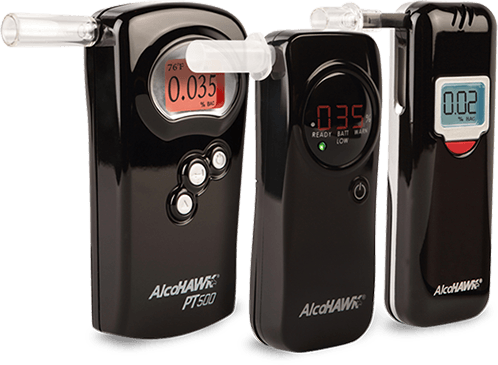How Does a Breathalyzer Work
 AlcoHAWK Selection Guide
AlcoHAWK Selection Guide
The purpose of the Breathalyzer Selection Guide is to provide you with a brief overview of breath alcohol testers so that you can make an informed decision about which alcohol tester is right for you. This guide summarizes how alcohol testers work and the factors to consider when selecting an alcohol tester. This guide also provides an overview of the four types of alcohol testers available today.
How Does a Breath Alcohol Test (Breathalyzer) Work?
When alcohol absorbs into your blood stream, it becomes possible to determine an individual's degree of intoxication by ascertaining the alcohol concentration percentage in the person's blood -- known as "blood alcohol concentration" ("BAC"). An individual's BAC can be measured two ways: (1) invasively (drawing a blood sample), and (2) non-invasively (breath, salvia, or urine samples). Invasive testing is generally performed at health care institutions by specialists equipped to perform the procedure, while non-invasive testing is used primarily by law enforcement officials because it is more feasible to perform. Of the different types of non-invasive testing, breath testing is the most common procedure because it is quick and less expensive.
Many people wonder how breath alcohol content (“BrAc”) is converted into BAC. As air moves in and out through the same set of respiratory tubes, continuous mixing of inhaled and exhaled air occurs. Air moves from the nose/mouth to the trachea to two tubes (one for each lung), known as the bronchi. The bronchi separate into several subdivisions, which end in a large number of tubules. At the end of the tubules are the alveoli, and a person's lung contains million of alveoli. Surrounding the alveoli is a fine network of capillary blood vessels. At this level the blood exchanges chemicals with the air in the lungs. Studies show that the alcohol concentration in the lower portion of the lungs is proportionate to the concentration of alcohol in the blood at a ratio of 2100:1.
To obtain an accurate correlation between blood and breath alcohol levels (typically 2100:1), the alcohol tester must be able to capture an air sample from the lower portion of the lungs. A person's vital capacity (volume of air that can be expelled without collapsing the lung) can range from 1 liter to 7 liters, depending on factors such as age, gender, physical condition, and disease status. If an alcohol tester requires too long of a breath sample before testing the person’s breath alcohol content, then the risk is that the person will not be able to provide a sufficient breath sample. On the other hand, if the alcohol tester captures a person’s breath alcohol content only after the person exhales a minimum amount of air, then the correlation between breath alcohol content and BAC will be poor. Typically, alcohol tester protocols will require the test subject to exhale air for at least 5 seconds to obtain a high correlation between BrAc and BAC.
Newer and more advanced alcohol testers can track the force of the exhale over time to ensure an adequate lung volume is achieved. Most Professional-grade alcohol testers measure the force of the breath sample to prevent “fake blowing” through the device and inaccurate results.
What factors are relevant when selecting
an accurate alcohol tester?
Many factors should be considered when selecting an alcohol tester. First and foremost, accuracy should be an important factor unless you are merely looking to purchase a novelty item at a low cost. If you care about accuracy, then it is important to compare the accuracy levels listed in the specifications for each unit. However, keep in mind that the accuracy reported in the specifications is often mistakenly viewed as the true accuracy of the unit when testing a human subject. The accuracies listed in the product specifications for each unit are usually based on a controlled testing environment using an alcohol simulator device. This does not account for the ability of the alcohol tester to capture an accurate breath sample. As a result, you should consider the following factors to determine the "true accuracy" of an alcohol tester:
Whether the alcohol tester is cleared by the Food and Drug Administration (FDA) and the Department of Transportation (DOT)/ National Highway Traffic Safety Administration (NHTSA).
The Food & Drug Administration (FDA) classifies breath alcohol testers as a Class I Medical Devices, which means the FDA must review and clear any breath alcohol tester to determine if it is safe and effective prior to the device being sold over-the-counter for personal use. It is a violation of federal law for a company to sell or distribute a breath alcohol detector for personal use if the device is lacking or pending FDA 510K clearance.
The National Highway Traffic Safety Administration (NHTSA), a division of the U.S. Department of Transportation (DOT), is responsible for testing breath alcohol testers to ensure the devices conform to the model specifications and accuracy requirements for use by law enforcement professionals throughout the USA. The AlcoHAWK® Series breathalyzers all have passed the FDA's 510(k) pre-marketing clearance process and meet the DOT/NHTSA's model specifications for breath alcohol screening devices.
Whether the alcohol tester captures a deep lung air sample and monitors pressure.
The best alcohol testers are capable of detecting both the duration and force of an exhale. Most individuals can easily blow a steady breath for at least four seconds. Confirming the force of the exhale is important when testing another individual because older devices that only capture breath samples after a specific period of time give the test subject the ability to exhale hard enough to activate the unit but then weaken their exhale in an attempt to provide a diluted sample.
Whether the alcohol tester requires mouthpieces to minimize the impact of external air.
We strongly recommend alcohol testers that require the use of a mouthpiece when capturing a breath sample. Any alcohol testers that do not require the use of a mouthpiece (known as Passive Testing Units) allow other air to mix with your breath sample, which can greatly alter the accuracy of the alcohol testers.
Whether the alcohol tester has good sensor accuracy in a controlled environment.
We recommend alcohol testers that have a sensor accuracy of at least +/- 0.01% at the point it is calibrated at in a controlled environment. For example is a unit is calibrated with a solution of 0.02% This means that repeated testing with a 0.02% simulated breath solution would not provide readings on the unit any higher than 0.03% and no lower than 0.01%.
Whether the alcohol tester can be recalibrated.
Over time, all alcohol testers may need recalibrated. Calibration is a process where you program the internal software so that it can gauge specific BAC levels. If the sensor becomes saturated, then the results can become skewed. This is because the unit was originally calibrated when the sensor was unsaturated. This process is sort of like winding a clock. When the clock is first set it displays accurate time. However, over time the clock gradually drifts a few minutes, and eventually can be off by quite a bit if you do not occasionally reset the clock. When selecting an alcohol tester, it is imperative to select a unit that is capable of being calibrated.
Overview of Types of Alcohol Tester Technologies
There are essentially four types of technologies to measure the air in lungs to individual's estimate BAC:
Semiconductor Sensor Models • Fuel-Cell Sensor Models • Infrared (IR) Spectroscopy Models • Gas Chromatography Models
Semiconductor Sensor Models
The presence of semiconductor units has increased rapidly over the past few years. The main advantage with these types of units is that they are relatively inexpensive. Since many semiconductor models are available, it is important to look at several relevant factors when selecting which unit is right for you. The Relevant Factors to Consider When Selecting a Breath Alcohol Tester are discussed above.
Based on the various factors to consider when selecting an alcohol tester, we break down semiconductor models into two catagories:
Novelty Grade and Professional Grade.
Novelty-Grade
Semi-Conductor Models
Many alcohol testers in the market are designed to test passive samples of breath, which means a breath sample is taken without the use of a mouthpiece. It is common to use passive testing because it is easy to simply test for the presence of alcohol on the breath. However, passive testing is typically less accurate and can often lead to unreliable results. The results of passive testing units are greatly altered by the surrounding environment as their sensor is highly exposed to any pollutants in the air. It is can also be difficult for the user to judge the correct distance to the space where to exhale into the unit.
Applications/Uses:
Personal Use, Unique Gift, Promotional Itam, Zero Tolerance Screening
Professional-Grade
Semi-Conductor Models
Professional grade units meet the strict requirements for approval by the Food and Drug Administration (FDA),and Department of Transportation (DOT)/National Highway Traffic Safety Administration (NHTSA). These units have a well-designed breath capture system and are programmed to test deep-lung air samples.
Applications/Uses:
Personal Use, Probation Officers, Non-eveidential Workplace Testing, Alcohol Abusing Clinics, Police Screeners, Military, Corrections, Schools, Parents
Recommended Professional-Grade Models:
Fuel Cell Models
Fuel Cell units are the gold standard of handheld alcohol testers. The fuel cell units are used by police officers, employers, substance abuse counselors and the like. Professional-grade semi-conductor units and fuel cell units have similar accuracy, but the fuel cell units are designed to be more specific towards alcohol detection. As a result, fuel cell units reduce the risk of false- positive readings from non-alcohol substances. Some of these units such as the Phoenix are designed for evidential testing, which means the results can potentially be used as evidence in a court of law. The only major draw back with fuel cell units is the cost, as they retail from $150 - $700 per unit.
Applications/Uses:
Evidential Testing (DOT-regulated workplace testing and for use in court), Law Enforcement Testing
Recommended Professional-Grade Models:
AlcoHAWK PT500 (non-evidential)
Infrared (IR) Spectroscopy and
Gas Chromatography Models
These units are utilized at police stations and are used mainly as evidential testers because they are extremely accurate and specific. These units are not yet manufactured to be handheld / portable units. These units are also very expensive, usually over $1000.



